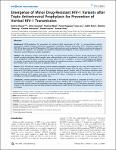Emergence of Minor Drug-Resistant HIV-1 Variants after Triple Antiretroviral Prophylaxis for Prevention of Vertical HIV-1 Transmission
Hauser, Andrea
Sewangi, Julius
Mbezi, Paulina
Dugange, Festo
Lau, Inga
Ziske, Judith
Theuring, Stefanie
Kücherer, Claudia
Harms, Gundel
Kunz, Andrea
Background: WHO-guidelines for prevention of mother-to-child transmission of HIV-1 in resource-limited settings recommend complex maternal antiretroviral prophylaxis comprising antenatal zidovudine (AZT), nevirapine single-dose (NVP-SD) at labor onset and AZT/lamivudine (3TC) during labor and one week postpartum. Data on resistance development selected by this regimen is not available. We therefore analyzed the emergence of minor drug-resistant HIV-1 variants in Tanzanian women following complex prophylaxis. Method: 1395 pregnant women were tested for HIV-1 at Kyela District Hospital, Tanzania. 87/202 HIV-positive women started complex prophylaxis. Blood samples were collected before start of prophylaxis, at birth and 1–2, 4–6 and 12–16 weeks postpartum. Allele-specific real-time PCR assays specific for HIV-1 subtypes A, C and D were developed and applied on samples of mothers and their vertically infected infants to quantify key resistance mutations of AZT (K70R/T215Y/T215F), NVP (K103N/Y181C) and 3TC (M184V) at detection limits of ,1%. Results: 50/87 HIV-infected women having started complex prophylaxis were eligible for the study. All women took AZT with a median duration of 53 days (IQR 39–64); all women ingested NVP-SD, 86% took 3TC. HIV-1 resistance mutations were detected in 20/50 (40%) women, of which 70% displayed minority species. Variants with AZT-resistance mutations were found in 11/50 (22%), NVP-resistant variants in 9/50 (18%) and 3TC-resistant variants in 4/50 women (8%). Three women harbored resistant HIV-1 against more than one drug. 49/50 infants, including the seven vertically HIV-infected were breastfed, 3/7 infants exhibited drug-resistant virus. Conclusion: Complex prophylaxis resulted in lower levels of NVP-selected resistance as compared to NVP-SD, but AZTresistant HIV-1 emerged in a substantial proportion of women. Starting AZT in pregnancy week 14 instead of 28 as recommended by the current WHO-guidelines may further increase the frequency of AZT-resistance mutations. Given its impact on HIV-transmission rate and drug-resistance development, HAART for all HIV-positive pregnant women should be considered.
Dateien zu dieser Publikation
Keine Lizenzangabe

